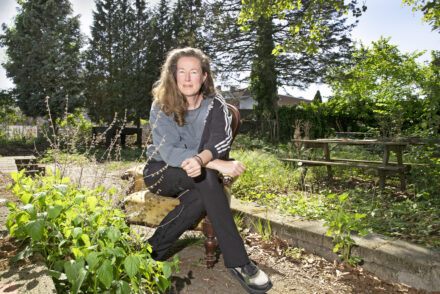Lessons of the Confession Tapes
If the Netflix hit series ‘The Confession Tapes’ shows anything clearly at all, it is that there’s something blatantly wrong with the US legal system. “Science is desperately needed to make Lady Justice act in a truly ethical way,” says philosopher Herman de Regt.
“I went upstairs to pick up the phone. My daughter was sleeping there. I saw the jerry can with petrol, turned it over a bit, spilled some, and then I lit a candle in her room – I just snapped.”
Karen Boes from Zeeland, Michigan (USA) tells her story. She was sentenced to life imprisonment for the murder of her 14-year-old daughter Robin. In the new Netflix hit series The Confession Tapes, which has been on display since 8 September, it’s explained how it all happened.
The Confession Tapes
Since the success of ‘Making a Murderer’, the series on the legal case involving Steven Avery and Brendan Dassey, who allegedly brutally raped and murdered a photographer, Netflix has been interested in series that take a critical look at the American system of justice. With The Confession Tapes, maker Kelly Loudenberg uses six examples to show what’s going wrong in a legal system that is literally preying on convictions. Binge watching? Yep!
The central point in all these cases is the total absence of any conclusive evidence – with the exception of the defendant’s confession. The series uses legally tape-recorded interrogations. As a viewer, we then witness the crucial moments in those taped sessions: those moments where the suspect confesses the crime.
The despair comes with the horrifying awareness that the confession is false and that the person gets life for a crime that he or she can’t have committed, or where at least doubt has arisen far beyond ‘reasonable’. The suspect should in fact be acquitted. But that doesn’t happen!
All these cases involve prosecutors, judges and/or jurors who base their judgment and verdict on a single assumption: “Anyone who is innocent would never ever admit to anything he hasn’t done”. After seeing The Confession Tapes, you’ll be yelling out loud: “Yeah, right…!
Intentional arson
Take the case of Karen Boes. A spoiler alert is not really needed here: even if you know what The Confession Tapes series is all about, the six nightmares will still grab you by the throat.
In her car, Karen gets a phone call saying that her house is on fire. She rushes home, where she arrives in panic. Her daughter Robin still appears to be in her bedroom. Karen desperately wants to go inside, but her husband stops her. Robin dies of smoke inhalation.
A ‘gas can’ is found in the totally burned out bedroom. The Court doesn’t rule out intentional arson. Karen, still mourning, is kindly invited to tell what really happened. Without a lawyer, she voluntarily speaks to the investigators. At that moment, she has no idea that this interview will last longer than ten (!) hours. Karen soon gets connected to a lie detector. She fails the test and the court concludes that Karen has deliberately set fire to kill her own daughter.
After a few hours of questioning under heavy mental pressure, Karen finally starts to think that she might have done it after all, but that she must have forgotten everything. Investigators ask: “Suppose you dreamed of it, how would it have evolved in your dreams?”
“I really don’t know what happened. Not consciously at least.”
“And unconsciously?”
Finally Karen admits: “Apparently I went upstairs to grab the phone. I saw that jerry can and turned it around a bit. I must have spilled petrol, and then I lit a candle in her room. I think I must have snapped”. On the basis of this one confession, a jury of twelve sentences Karen to life imprisonment. Oh boy, a lot is wrong in the judicial system of ’the country of hope’ – feel free to call it ’the country of despair’. In the light of The Confession Tapes and because of a lack of writing space, I’ll mention only three of those wrongs.
1. Memory is malleable
The moment Karen was asked to present herself as the perpetrator, the scientific research done by Loftus becomes more than just relevant. People believe in imaginary scenarios all too quickly. The famous ‘Lost in the Mall’ experiment shows that subjects easily get convinced that something that never happened really did happen. In the mall experiment, it’s a ‘juvenile trauma’, where the subject got lost in a shopping mall at an early age, although this never really happened. Imagining that it did happen, in combination with slight pressure from accomplice family members, increases the chance that the subject starts to believe it really did happen. The police has to take this effect into account. In the case of Karen, this is crucial. She remembers something she probably didn’t do.
2. Breaking point
After more than 10 hours of questioning, more and more old survival instincts gain the upper hand. The subject only wants one thing: that the torture stops. Charles Darwin and others have emphasized, on the basis of extensive biological research, that we are family of all other living beings on this planet. And all these organisms only want one thing when they are being cornered: to get away from it all as quickly as possible. Mental pressure in a psychologically very stressful situation makes one do or say the things an oppressor wants to see or hear – under the promise that then everything will be over. Karen didn’t stand a chance: “Everyone has a breaking point”. You and I do, too.
3. No alternative scenario or doubt
It has already been pointed out in previous miscarriages of justice that judges, prosecutors and jurors don’t seem to understand that a hypothesis about the sequence of events that fits in with the available evidence, can only be validated through comparison of this hypothesis with alternative hypotheses that also fit in. This triangular relationship between two competing hypotheses and the empirical material has been emphasized many times in the philosophy of science. A false confession can often be exposed in the light of an alternative hypothesis, one that is in fact much more likely. But the judicial investigation gets stuck on the idea that the accused has to be the perpetrator. Without an alternative, a scenario is worth nothing, but one single fitting scenario already feels good. The case has been resolved and we experience a pleasant sense of comprehension. Few jury members will continue to doubt the question of guilt in the light of a confession. It offers a fast route away from doubt. In fact, continuing to doubt and thinking slowly requires a lot of effort, energy and training.
Making a Murderer

The cases presented in The Confession Tapes are just as poignant as the famous Brendan Dassey court case, presented in Making a Murderer. Dassey was sentenced to life imprisonment in 2007, only on the basis of an involuntary, and most likely false, confession made at the age of 16. On 26 September this year, his case was re-opened and examined in Chicago, by a panel of seven judges of the Seventh Circuit Court of Appeals. Unfortunately, the results are still pending; first reports in the Chicago Tribune state that the case is now really getting down to the wire. However, if Dassey is released, his case will set an enormous precedent for similar cases, such as those in The Confession Tapes!
Science and justice
It’s clear that science is simply indispensable to explain when and how cognitive biases and evolutionary properties lead to miscarriages of justice. As many people as possible should be taught the correct concept of what science is and can do. Those who play a judicial role (jurors in America, too!) can’t do without proper training in slow thinking. Based on the publication of such scientific research and training, criminal justice can be improved. After all, the ethical task seems to be: letting twenty guilty people escape death, rather than depriving one innocent person of his freedom.
The pledge of allegiance
When I was allowed to work in Princeton, my teenage daughters went to the local school. Like all the American children, they made the pledge of allegiance every (!) morning, right hand on the heart: “I pledge allegiance to the flag of the United States of America, and to the republic for which it stands, one nation under God, indivisible, with liberty and justice for all.” After seeing Making a Murderer and The Confession Tapes, we can now ask ourselves what this ‘and justice for all’ actually means in practice.






